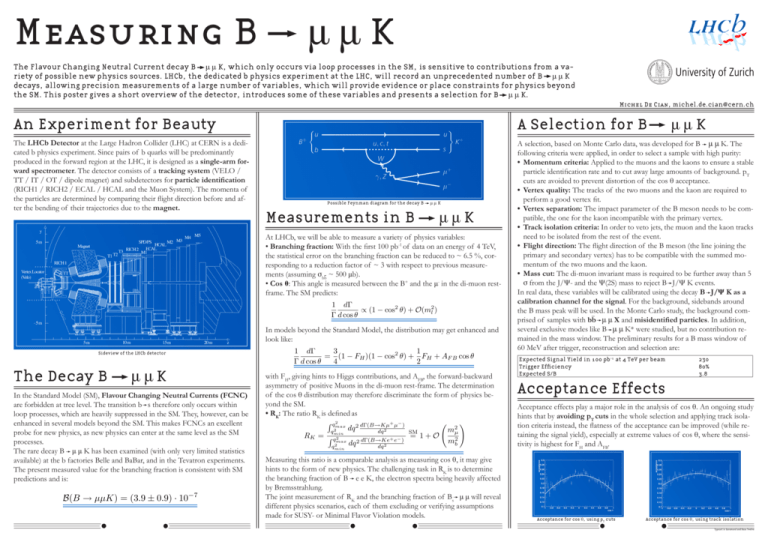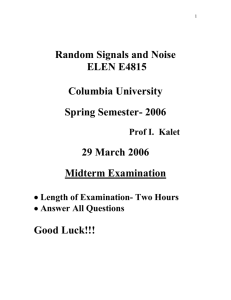An Experiment for Beauty The Decay B μ μ K Measurements in B μ μ
advertisement

Measuring B μ μ K The Flavour Changing Neutral Current decay B μ μ K, which only occurs via loop processes in the SM, is sensitive to contributions from a variety of possible new physics sources. LHCb, the dedicated b physics experiment at the LHC, will record an unprecedented number of B μ μ K decays, allowing precision measurements of a large number of variables, which will provide evidence or place constraints for physics beyond the SM. This poster gives a short overview of the detector, introduces some of these variables and presents a selection for B μ μ K. Michel De Cian, michel.de.cian@cern.ch μμK An Experiment for Beauty A Selection for B The LHCb Detector at the Large Hadron Collider (LHC) at CERN is a dedicated b physics experiment. Since pairs of b quarks will be predominantly produced in the forward region at the LHC, it is designed as a single-arm forward spectrometer. The detector consists of a tracking system (VELO / TT / IT / OT / dipole magnet) and subdetectors for particle identification (RICH1 / RICH2 / ECAL / HCAL and the Muon System). The momenta of the particles are determined by comparing their flight direction before and after the bending of their trajectories due to the magnet. A selection, based on Monte Carlo data, was developed for B μ μ K. The following criteria were applied, in order to select a sample with high purity: • Momentum criteria: Applied to the muons and the kaons to ensure a stable particle identification rate and to cut away large amounts of background. pT cuts are avoided to prevent distortion of the cos θ acceptance. • Vertex quality: The tracks of the two muons and the kaon are required to perform a good vertex fit. • Vertex separation: The impact parameter of the B meson needs to be compatible, the one for the kaon incompatible with the primary vertex. • Track isolation criteria: In order to veto jets, the muon and the kaon tracks need to be isolated from the rest of the event. • Flight direction: The flight direction of the B meson (the line joining the primary and secondary vertex) has to be compatible with the summed momentum of the two muons and the kaon. • Mass cut: The di-muon invariant mass is required to be further away than 5 σ from the J/Ψ- and the Ψ(2S) mass to reject B J/Ψ K events. In real data, these variables will be calibrated using the decay B J/Ψ K as a calibration channel for the signal. For the background, sidebands around the B mass peak will be used. In the Monte Carlo study, the background comprised of samples with bb μ μ X and misidentified particles. In addition, several exclusive modes like B μ μ K* were studied, but no contribution remained in the mass window. The preliminary results for a B mass window of 60 MeV after trigger, reconstruction and selection are: Possible Feynman diagram for the decay B μμK Measurements in B μμK At LHCb, we will be able to measure a variety of physics variables: • Branching fraction: With the first 100 pb-1 of data on an energy of 4 TeV, the statistical error on the branching fraction can be reduced to ~ 6.5 %, corresponding to a reduction factor of ~ 3 with respect to previous measurements (assuming σbb ~ 500 μb). • Cos θ: This angle is measured between the B+ and the μ- in the di-muon restframe. The SM predicts: 1 dΓ ∝ (1 − cos2 θ) + O(m2l ) Γ d cos θ In models beyond the Standard Model, the distribution may get enhanced and look like: Sideview of the LHCb detector The Decay B μμK In the Standard Model (SM), Flavour Changing Neutral Currents (FCNC) are forbidden at tree level. The transition b s therefore only occurs within loop processes, which are heavily suppressed in the SM. They, however, can be enhanced in several models beyond the SM. This makes FCNCs an excellent probe for new physics, as new physics can enter at the same level as the SM processes. The rare decay B μ μ K has been examined (with only very limited statistics available) at the b factories Belle and BaBar, and in the Tevatron experiments. The present measured value for the branching fraction is consistent with SM predictions and is: B(B → µµK) = (3.9 ± 0.9) · 10−7 3 1 1 dΓ 2 = (1 − FH )(1 − cos θ) + FH + AF B cos θ Γ d cos θ 4 2 with FH, giving hints to Higgs contributions, and AFB, the forward-backward asymmetry of positive Muons in the di-muon rest-frame. The determination of the cos θ distribution may therefore discriminate the form of physics beyond the SM. • RK: The ratio RK is defined as 2 qmax + − 2 dΓ(B→Kµ µ ) 2 dq 2 mµ dq 2 qmin SM RK = q 2 = 1+O + e− ) 2 dΓ(B→Ke max 2 m dq b 2 2 qmin dq Measuring this ratio is a comparable analysis as measuring cos θ, it may give hints to the form of new physics. The challenging task in RK is to determine the branching fraction of B e e K, the electron spectra being heavily affected by Bremsstrahlung. The joint measurement of RK and the branching fraction of Bs μ μ will reveal different physics scenarios, each of them excluding or verifying assumptions made for SUSY- or Minimal Flavor Violation models. Expected Signal Yield in 100 pb-1 at 4 TeV per beam Trigger Efficiency Expected S/B 230 80% 3.8 Acceptance Effects Acceptance effects play a major role in the analysis of cos θ. An ongoing study hints that by avoiding pT cuts in the whole selection and applying track isolation criteria instead, the flatness of the acceptance can be improved (while retaining the signal yield), especially at extreme values of cos θ, where the sensitivity is highest for FH and AFB. Acceptance for cos θ, using pT cuts Acceptance for cos θ, using track isolation Typeset in Garamond and Base Twelve






![First observation of [¯ over B][superscript 0]](http://s2.studylib.net/store/data/012086025_1-f3117b8556b080153e47fc8ad53d2a59-300x300.png)